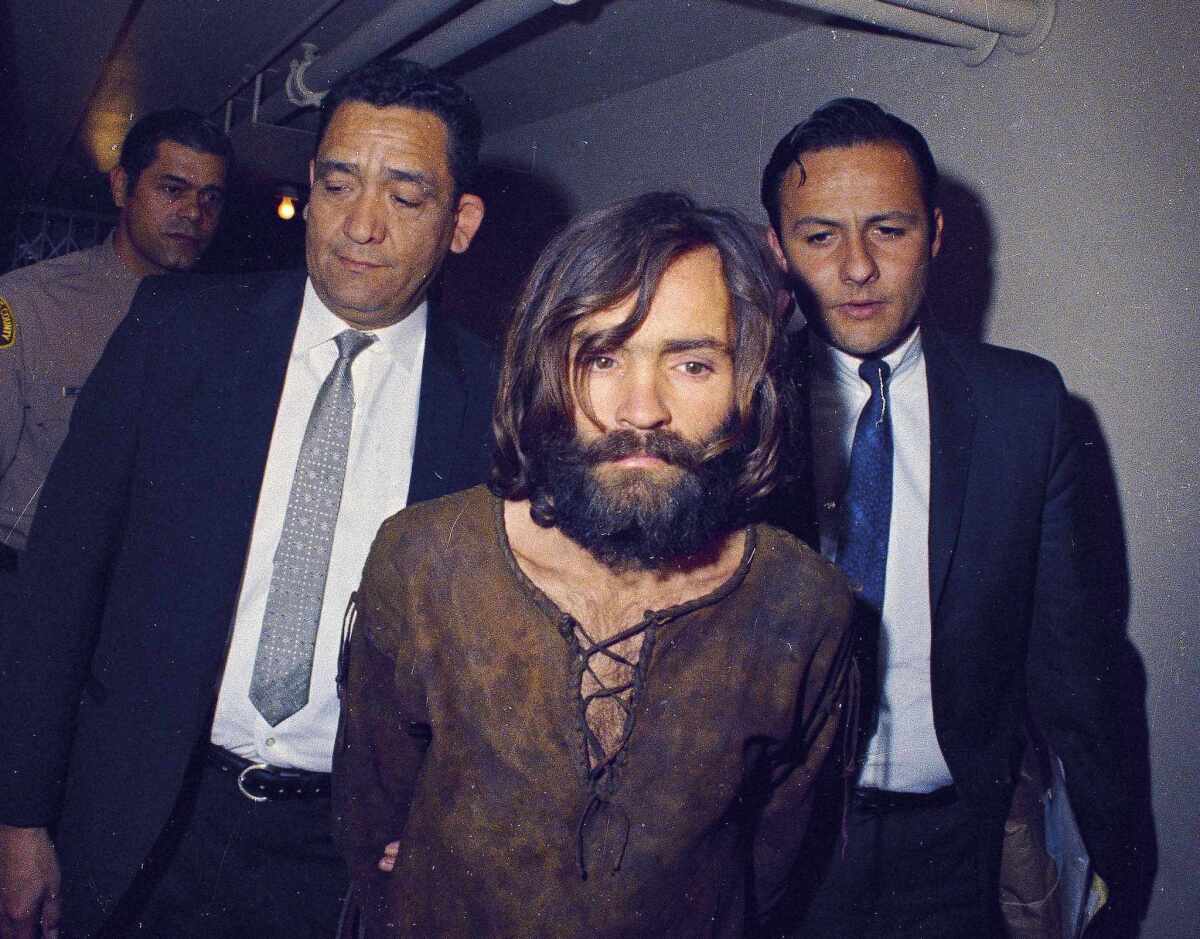Do we need another story about Charles Manson? Why Angelenos can’t look away
- Share via
The new Epix docuseries “Helter Skelter: An American Myth” is a six-part production chronicling the ominous ascent of the Manson Family, from its flower-power beginnings to its heinous killing spree in the summer of 1969.
The compelling series, which premiered July 26, is full of illuminating archival footage of Manson, his followers and the environs that shaped their anomalous ascent. Each hourlong episode features new interviews with former cult members, those who knew them or their victims, and those involved in solving their horrific crimes.
But do we really need another production about this racist madman and his druggie sycophants turned assassins? They’ve been immortalized in countless narratives about this especially creepy chapter in the history of American crime, from last year’s “Mindhunter” and “Once Upon a Time ... in Hollywood” all the way back to the granddaddy of Manson narratives, prosecutor Vincent Bugliosi’s 1974 book “Helter Skelter: The True Story of the Manson Murders.”
The answer is yes: More than half a century later, the Manson Family’s tale still resembles a fever dream. Storytellers can’t help but re-explore the story of Charlie, a diminutive ex-con, pimp and aspiring musician who amassed a following of mostly young women, plied them with LSD, sex and antiestablishment jargon, then convinced them to kill in the name of a race war. They lived on a commune. They mingled with, and murdered, celebrities. It all happened behind the deceptive cloak of peace and love. No wonder we can’t stop watching.
Both Netflix’s “Mindhunter” and Quentin Tarantino’s “Once Upon a Time ... in Hollywood” downplay — or erase — Charles Manson’s white supremacist ideology.

Yet there’s something else that attracts me to new stories about Patricia, Tex and the cult, something that’s oddly personal, if not provincial. Weird as it sounds, I have a sense of shared history with these horrible people simply because I grew up in their shadow.
I’m a native Angeleno, raised in the 1970s under a brown inversion layer not dissimilar to one that crowned the San Fernando Valley when the family had its reign of terror. Proximity alone has meant that my life has continually intersected with their legacy and the countercultural confusion they left behind. The notion of killers disguised as peaceniks may explain why I gravitated toward punk rock rather than pining for their generation’s songs about harmony and brotherhood. Like many of my peers, my associations with hippie culture were as much about local madman Manson as faraway Woodstock.
Nostalgia and familiarity are not what I should be feeling watching “Helter Skelter,” directed by Lesley Chilcott (“An Inconvenient Truth”), or Quentin Tarantino’s Oscar-winning feature, but it’s hard not to when they’re both so deeply immersed in my own SoCal mythology.
For example, the Epix docuseries’ mention of “Charlie’s girls” dumpster-diving for food in back of markets across the Valley brought back memories of places where my mom used to grocery shop. When the series shows footage of Manson’s followers riding horses and smoking weed in the Santa Susana Pass, the rock formations behind them are so recognizable I can close my eyes and trace their outline perfectly with my finger. I grew up playing in those hills around Chatsworth Park, hiking the caves and boulders where they’d partied. My daily school bus ride took me past the old Spahn Ranch site. And later in high school, when we could drive up ourselves, we’d search for the fabled row of palm trees where Family members supposedly carved their names.
I associate images of the LaBiancas’ Los Feliz home, where the couple were tortured and murdered in 1969, with my first apartment. It was a block from the scene, on a street where I’d frequently walk my dogs out of duty and, if I’m honest, morbid curiosity. And as a music fan, I frequented the clubs where Manson once tried (and failed) to become a rock star. He watched Buffalo Springfield at the Troubadour. I watched Social Distortion. We may have been generations apart, but by the time I was established enough to interview real rock stars, one of my first big breaks was talking to NIN’s Trent Reznor inside the Cielo Drive home where Sharon Tate, Jay Sebring, Abigail Folger, Wojciech Frykowski and Steven Parent were murdered.
The home was demolished soon after, in 1994, but every time it’s pictured in photos or re-created for a scripted production, the horror of those murders is mixed with my own memories of sitting in the living room beneath those thick wood ceiling beams, walking around the kidney-shaped swimming pool and peering out the Dutch door at sweeping views of the city.
And no matter what, Topanga Canyon still feels haunted to me. It’s where the family moved in with Beach Boy Dennis Wilson, killed associate Gary Hinman and where Charlie played a dismal set at the Topanga Corral. One aspect that helps separate the Epix series from my own experience is a soundtrack replete with Manson’s awful recordings. It’s clear now why he had to amass a following some other way than through his music.
Harder to explain than the Manson Family’s invisible imprint on L.A. is why the San Fernando Valley was the perfect incubator for such a deadly aberration. A suburb of Los Angeles where middle-class families had the chance to thrive, the Valley was close enough to access the celebrity of Hollywood, as Manson did, but also far enough away to forget about the privileged lives of L.A.’s beautiful people. The Valley was rough around the edges — Topanga Canyon Boulevard was lined with horse pastures, the 118 Freeway was rolling hills — so there was plenty of undeveloped space for a broke band of misfits to create their own warped ecosystem.
The Valley was a basin of contradictions — wholesome drive-in theaters and a thriving porn industry (see “Boogie Nights”), Topanga’s psychedelic scene, showbiz rich and famous and normal folk like Leno and Rosemary LaBianca. Manson and his family moved between all those worlds, which seems absurd today. But in a city that prides itself on bucking the status quo and starting new trends, who was going to take notice of one more long-haired weirdo waxing poetic?
The connection I have to these felons and their awful legacy is troublesome, but they are part of local history — part of the messed-up place where I was raised, where nothing was ever as safe or sedate as everyone kept insisting it was. And that’s a story that never gets old.
‘Helter Skelter: An American Myth’
Where: Epix
When: 10 p.m. Sunday
Rating: TV-MA (may be unsuitable for children under the age of 17)
More to Read
The complete guide to home viewing
Get Screen Gab for everything about the TV shows and streaming movies everyone’s talking about.
You may occasionally receive promotional content from the Los Angeles Times.








